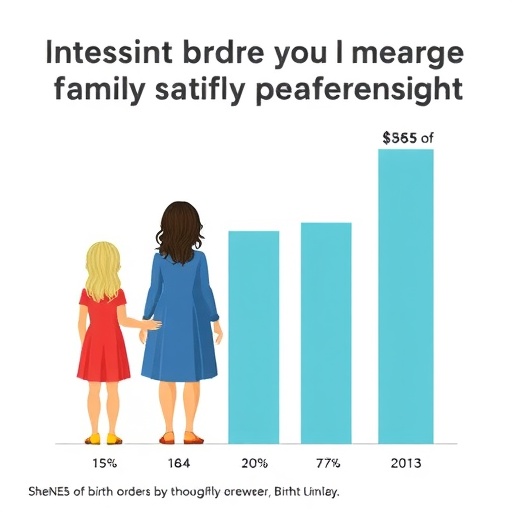In recent years, the intricate dynamics of family composition in developing countries have gained significant attention among researchers. A notable contribution to this field comes from the groundbreaking study by Ranjan, Sinha, and Lalrotlinga, which delves into the fascinating intersections between birth sex sequence and desired family size in India. Their research is pivotal in understanding the nuanced preferences that shape family planning decisions, highlighting how societal values and cultural norms interplay with demographic data.
The study employs advanced statistical methods, specifically multinomial regression analysis, to uncover patterns that may not be immediately apparent through traditional analysis. This method allows researchers to assess how various factors influence family composition preferences among Indian households. By considering not only the sex of the firstborn but also the subsequent children, the authors provide a comprehensive analysis that reveals deeper insights into societal attitudes towards gender and family dynamics.
One of the key findings of the study is the significant role that the sex of the first child plays in determining the overall desired family size. In many Indian households, cultural preferences often favor sons over daughters, which can lead to families desiring more children if the firstborn is a girl. This underlying sentiment reflects the broader societal trends wherein male offspring are often viewed as providers for the future, causing a ripple effect on family planning strategies across various demographics.
Moreover, the research reveals varying preferences based on regional and economic factors. For instance, in rural areas where traditional values hold stronger sway, families are likelier to express a desire for multiple children, particularly if their initial child is of the female sex. In contrast, urban families tend to lean toward smaller family sizes, reflecting shifts in cultural values and economic pressures. This divergence illuminates the complexity of family planning choices in India, suggesting that policies aimed at addressing population growth must be tailored to specific regional contexts and cultural beliefs.
The implications of this study extend beyond academia, influencing policymakers and social planners as they craft initiatives aimed at improving gender equity and reproductive health. By understanding the relationship between birth sex sequence and family size preferences, stakeholders can design targeted interventions that address gender bias in family planning while also promoting healthier family dynamics. The broader goal is to create a societal shift that values daughters equally to sons, fostering an environment where parental attitudes are informed by child welfare and individual aspirations rather than traditional gender roles.
Nonetheless, the authors caution against interpreting their findings in isolation. Socioeconomic variables, such as education level and income, also play a crucial role in shaping family preferences. Higher educational attainment is often linked to a desire for smaller family sizes, as educated parents tend to prioritize economic stability and quality of life over larger familial structures. This intersection between education and parenting decisions underscores the importance of comprehensive educational initiatives that empower women and provide equal opportunities for all genders.
Another essential aspect highlighted in the research is the role of government policies and public health initiatives in influencing family planning decisions. Access to reproductive health services and education can significantly alter family size preferences, thereby challenging traditional norms surrounding gender and childbearing. The evolution of policy frameworks aimed at promoting gender equity is crucial to reshaping societal attitudes about family composition in India and beyond.
While the study adeptly illustrates the depth of familial preferences linked to birth sex sequence, it also sparks important conversations about reproductive rights. These discussions emphasize the need for a balanced perspective that respects cultural values while advocating for gender equality. It is vital for societies to collectively recognize that the preference for sons over daughters not only perpetuates gender discrimination but also has far-reaching consequences for societal growth and development.
The research by Ranjan and colleagues stands as a testament to the evolving nature of family dynamics in India and highlights the pressing need for continued exploration of this topic. As communities grapple with rapid changes brought on by globalization and modernization, understanding the underlying factors that shape family preferences becomes increasingly vital. Researchers are encouraged to pursue further studies that investigate the long-term effects of changing family dynamics on society, culture, and individual well-being.
Ultimately, the findings of this research challenge scholars and practitioners alike to confront difficult questions concerning tradition, gender, and reproductive rights. As India navigates its path toward sustainable development and social equity, embracing nuanced understandings of family composition will be crucial in achieving these goals. The intricate tapestry of cultural values, economic realities, and demographic preferences must be woven together to create a holistic approach to family planning that is equitable and sustainable.
In conclusion, Ranjan, Sinha, and Lalrotlinga’s study serves not only as a scholarly contribution but also as a call to action for a reassessment of societal norms regarding family structure and gender preferences. As these researchers illuminate the multifaceted relationships between birth sex, family size, and societal values, they provide a roadmap for understanding and potentially recalibrating the deeply entrenched biases that continue to shape family composition in India. The journey towards gender equality and inclusive family planning is ongoing, necessitating a commitment from all sectors of society to embrace change and foster a culture that values every child, regardless of gender.
Subject of Research: The effect of birth sex sequence on desired family composition in India.
Article Title: A multinomial regression analysis of the effect of birth sex sequence on desired family composition in India.
Article References:
Ranjan, M., Sinha, A.K. & Lalrotlinga A multinomial regression analysis of the effect of birth sex sequence on desired family composition in India.
J Pop Research 42, 32 (2025). https://doi.org/10.1007/s12546-025-09383-0
Image Credits: AI Generated
DOI:
Keywords: Family composition, birth sex sequence, multinomial regression, India, gender bias, family dynamics.




